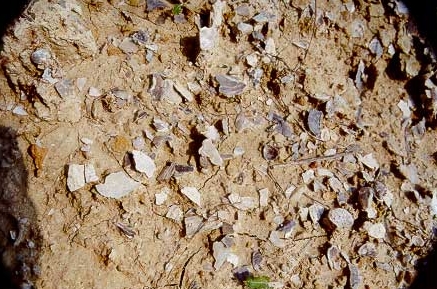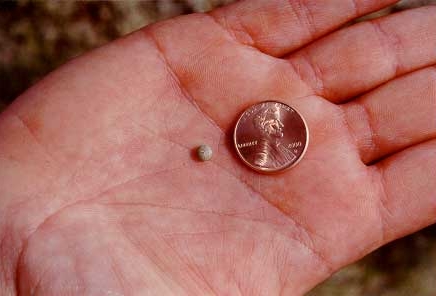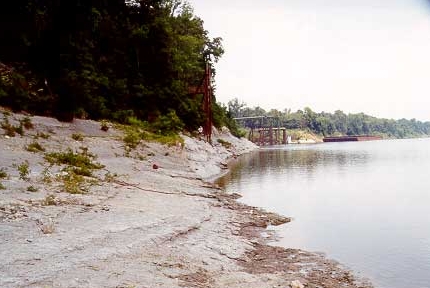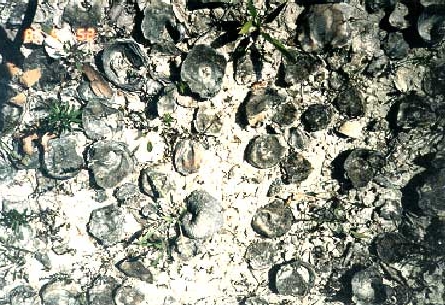This report (installed on Sept. 27) is late because of the month-long trip to South Africa that I took from mid-July to mid-August. As a result, I can only roughly describe what the BPS did this day. There were three sites in Sumter County that were visited, all well-known and previously visited by the BPS.
| There are numerous Late Cretaceous chalk exposures in Sumter Co. One of
these is found in a field near Livingston, and includes numerous
shells, shell fragments, and other fossils (see Figures 1 and 2). The
site is visited annually by various groups, and is known for the tiny
echinoids (Boletechinus mcglamerii) which can be found there. Several
were found on this day, one of which is shown in Figure 3. | 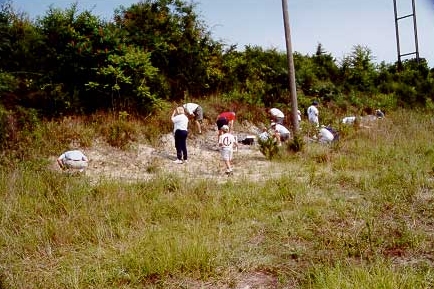 |
| | Fig. 1 - BPS members and guests collecting Late
Cretaceous marine fossils. |
| |
| Fig. 2 - Close-up view of a small part of
the outcrop, showing numerous shells and shell fragments. The whole area
shows a similar distribution of fossils. |
| |
| Fig. 3 - One of the small echinoids this site is
famous for having. The echinoids are called Boletechinus mcglamerii, and are
named for one of Alabama’s state paleontologists, Winnie McGlamery,
according to Dave Kopaska-Merkel. |
| One of the highlights of the visit was the apparent fossil "claw" held
by Alan Collins in Figure 4. The interpretation as a "claw" is not
clearcut , however. Dave Kopaska-Merkel (Geological Survey of Alabama)
suspects the piece could also be the hinge of a large oyster. |  |
| | Fig. 4 - Possible claw (or, alternatively, the hinge
of a large oyster), held by Alan Collins. |
| Figure 5 shows a general mix of the types of fossils found at this site
in abundance, including internal molds of bivalved mollusks,
steinkerns, small scallops, and oyster shells. Larger oyster shells of
the genus Exogyra are also found. I originally thought the internal
molds were of brachiopods, but Dave Kopaska-Merkel notes that
brachiopods have calcite shells while many mollusks have aragonite
shells. We mostly see internal molds of these bivalve mollusks because
aragonite is much more susceptible to dissolution. |  |
| | Fig. 5 - A sampling of the fossils from the site,
including oyster valves, internal molds of bivalve mollusks, steinkerns, and
a small scallop shell. |
After spending more than an hour at this site in the intense heat,
the BPS went to a site on the Tombigbee River where fossils around the
K-T boundary are exposed (see Figures 6 and 7). The K-T boundary is the
boundary between the end of the Cretaceous period and the beginning of
the Tertiary period of Earth history. The site is well-studied and the
personal favorite I have heard of Dr. Charles C. Smith of the
Geological Survey of Alabama. Dr. Smith has written articles about the
site and has published a stratigraphic profile showing the connection
between the Late Cretaceous Prairie Bluff Chalk and the overlying
Tertiary Clayton Formation. Once we arrived at the site, Dr. Andy
Rindsberg (also of the GSA) gave the BPS a brief discussion of the
significance of the site and what we could expect to find there. After
spending a month in South Africa where fossil collecting is highly
regulated, I am, in retrospect, surprised that we are allowed to
collect at this site. Still, it was a great pleasure to do this and
extremely educational. 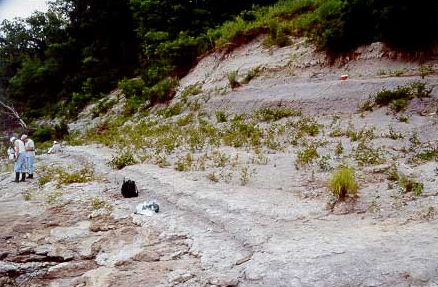 | Fig. 6 - Tombigbee River, in
Sumter County. The K-T boundary is to the left of the backpack, at the point
where the chalk color changes from light gray to a light brown. |
|
| |
| |
| Fig. 7 - View of river facing in opposite direction
from Figure 6. |
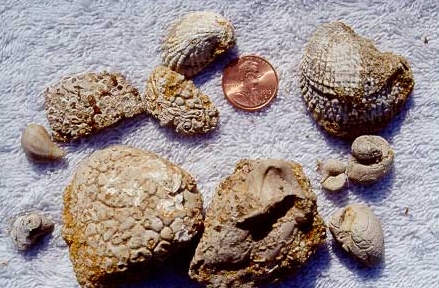 | Fig. 8 - Cretaceous fossils from the light brown area,
just below the K-T boundary in Figure 6. Includes oyster shells (Exogyra
costata), some steinkerns, and internal molds of bivalve mollusks affected
by boring sponges. |
On looking at the boundary, one readily notices that the fossils below
are different from the ones above. Figures 8 and 9 show some of the
lower fossils while Figure 10 shows the upper fossils. Oysters from
below include Exogyra costata, while those from above include Ostrea
pulaskensis ("pulies" for short according to Andy Rindsberg). I think
the pulies are the small gray oysters in Figure 10. Figure 9 shows some
gastropods, internal molds, and a fragment of a cephalopod shell that I
at first thought was a crinoid stem. Also, Figures 8 and 9 show strange
fossils, probably connected with large bivalve mollusks, that have a
"brain matter" look. According to Dave Kopaska-Merkel, sponges bored
into the aragonitic shells of the bivalves, and their borings become
filled with calcitic mud. Later, the aragonite dissolved, but the
filled borings remained and these preserved the general form of the
shells. |
| |
| |
| Fig. 9 - Cretaceous fossils from closer to the river,
including gastropods, internal molds of bivalve mollusks with holes due to
boring sponges, and a fragment of a cephalopod shell. |
| |
| Fig. 10 - Tertiary fossils from the light gray area,
just above the K-T boundary in Figure 6. The small gray shells are Ostrea
pulaskensis. |
The third site the BPS had planned to visit was the oyster fields
in the Belmont area. I did not attend this part of today’s trip, but I
have been there before, and show in Figures 11 and 12 photographs I
took two years ago. The site is absolutely remarkable in the large
numbers of giant Exogyra and Pycnodonte oyster shells. A variety of
shells are found at this site and are summarized in a pamphlet provided
by the GSA. | 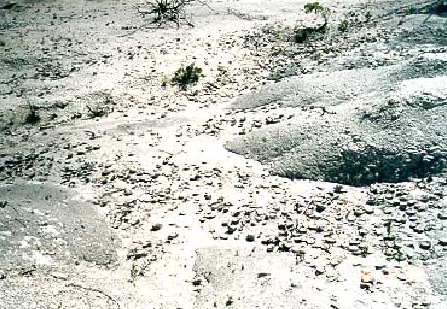 |
| | Fig. 11 - A field of Late Cretaceous oyster shells,
near Belmont, Alabama. |
| |
| Fig. 12 - A close-up of a typical area in one of the
above fields, showing shells mainly of the genera Exogyra and Pycnodonte. |
In summary, this was a very pleasant and interesting field trip for the BPS. Given how much time many of us have spent at the Union Chapel Mine collecting tracks and plant fossils recently, today’s trip was a nice break from the strip mine rock piles. Thanks to Dave Kopaska-Merkel for comments and revisions to this belated report!

